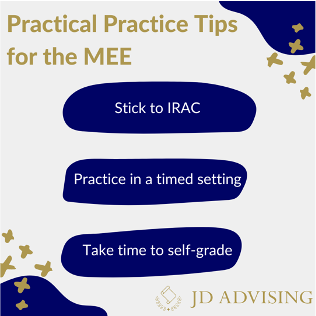Nervous about the MEE? Try These Practice MEE tips!
Nervous about the MEE? Try These Practice MEE tips!
The Multistate Essay Examination (MEE) is a critical component of the Uniform Bar Exam, testing your ability to apply legal principles and reason in a written format. It’s essential to refine your approach and tactics heading into the MEE so you can maximize your score. In this blog, we will delve into practical tips to practice for the MEE so you can walk into the bar exam with confidence on test day!
Nervous about the MEE? Try These Practice MEE tips!
Stick to IRAC
IRAC, which stands for Issue, Rule, Analysis, and Conclusion, is a fundamental structure for legal writing and a pivotal strategy for the MEE. Using IRAC helps in organizing your thoughts and presenting your arguments clearly and coherently. Let’s break down each component:
Issue
Start by identifying the legal issues presented in the question. Many MEE questions even provide you with the specific issue that they expect you to analyze! Clearly state the issue to demonstrate your understanding of what the question is asking. We recommend incorporating your issue statement as a heading in your MEE response, so you can immediately move to your rule statement.
Rule
Next, articulate the relevant legal principles or rules that apply to the issue. This part of your answer should demonstrate your knowledge of the law. Make sure to state the rules precisely and accurately to maximize the number of points. Also, note that some MEE questions want you to navigate between majority and minority approaches to different legal principles. As you work your way through your studies, make sure you’re committing multiple approaches to memory so you can easily recall them on the MEE!
Analysis
Here, you’ll apply the rule to the facts of the problem. This is where you show your ability to reason, compare, and contrast. Discuss how the rule interacts with the facts, considering any potential counterarguments. Make sure you’re actually applying the facts to the rule and not just listing them. Your grader needs to understand how you reach your conclusion, and you can only lead the grader to your conclusion by applying the facts to the rule!
Conclusion
Finally, conclude by summarily answering the issue based on your analysis. Your conclusion should be a direct response to the issue you identified, reflecting the logic and reasoning in your analysis. While law school essays don’t always want you to come to a pointed conclusion, the MEE often does. So, keep this in mind as you’re practicing your essays!
Practice in a Timed Setting
Practicing MEE questions in a timed setting is crucial for developing time management skills. Here’s how you can effectively do this:
Set a Timer
To mimic exam conditions, make sure you allocate 30 minutes per essay. Starting your preparation with this time constraint helps in building your ability to think, organize, and write quickly. It might take some time for you to answer a full MEE in 30 minutes, which is why it is important to practice!
Simulate Exam Conditions
Try to replicate the conditions of the exam as closely as possible. This means working in a quiet space and adhering strictly to the time limit. If you find yourself struggling to stimulate exam conditions at home, try working at a library or an empty classroom at your law school to help remove some of the distractions.
Take Time to Self-Grade
Self-grading is a powerful tool for self-assessment and improvement. Here’s how to do it effectively:
Compare with the Examiner’s Analysis
After writing your essay, take time to compare it with the examiner’s analysis. You can also use your outline to identify the rules you may have missed if you find the examiner’s analysis too dense to walk through. Also, be sure to check out model student answers! These can be valuable if you’re not entirely sure how to approach or navigate certain issues.
Analyze Your Answer
Look at each component of your answer – the issues, rules, analysis, and conclusion. Check if you’ve missed any significant issues or rules, and assess the depth and clarity of your analysis. If you find yourself missing rules or analysis, make sure you add them to your answer using a different color font. You can also add them to a nearby notebook so you can make sure you’re practicing those rules later!
Give Yourself a Score
Assign a score to your essay. This will help you track your progress over time and identify areas where you consistently need improvement. Many students don’t feel confident in scoring their essays, but if you’re taking self-grading seriously, you’ll be surprised how accurate your scores might be! Check out this blog post for more information on how to score your essays.
Looking to Pass the Bar Exam?
Free Resources:
- 🌟Bar Exam Free Resource Center: Access our most popular free guides, webinars, and resources to set you on the path to success.
- Free Bar Exam Guides: Expert advice on the MBE, the MEE, passing strategies, and overcoming failure.
- Free Webinars: Get insight from top bar exam experts to ace your preparation.
Paid Resources:
- 🏆One-Sheets: Our most popular product! Master the Bar Exam with these five-star rated essentials.
- Bar Exam Outlines: Our comprehensive and condensed bar exam outlines present key information in an organized, easy-to-digest layout.
- Exclusive Mastery Classes: Dive deep into highly tested areas of the MBE, MEE, MPT, and CA bar exams in these live, one-time events.
- Specialized Private Tutoring: With years of experience under our belt, our experts provide personalized guidance to ensure you excel.
- Bar Exam Courses: On Demand and Premium options tailored to your needs.
- Bar Exam Crash Course + Mini Outlines: A great review of the topics you need to know!
🔥 NEW! Check out our Repeat Taker Bar Exam Course and our new premier Guarantee Pass Program!








Leave a Reply
Want to join the discussion?Feel free to contribute!